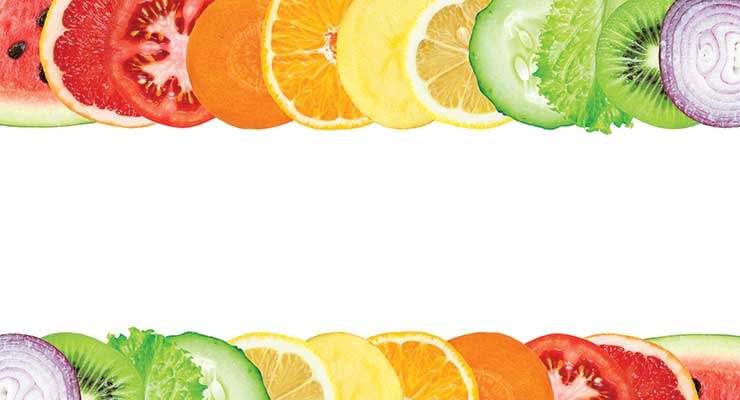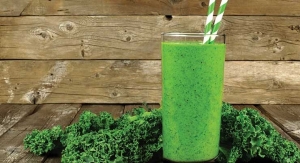Sean Moloughney, Editor06.01.15
Color plays a significant role in attracting consumers to a product, and an equally important part in meeting their expectations for that purchase. Bright red apples or dark green vegetables convey freshness and flavor, alerting potential buyers to their natural ripeness. The orange-pink hue from salmon, imbued by the carotenoid astaxanthin, offers an appetizing allure at the point of purchase.
Food/beverage and supplement manufacturers use colors as tools to entice consumers and to deliver specific expectations of taste. Colorants are found in most packaged foods and beverages, noted Golan Raz, vice president of the health and nutrition division at Lycored, Orange, NJ.
“When the color included is minimal it will not affect the flavor. The colorant’s key functionality rallies around perception and to reflect freshness and stability of the products. Many times, the brighter the color the fresher it is, though when we translate it to real food, for instance, strawberries are sweeter the darker they get.”
However, as more people evaluate product labels and look to avoid artificial additives, companies have begun abandoning synthetic dyes in favor of natural color options.
According to Georges Bergen, senior regulatory affairs manager at DSM Nutritional Products, Parsippany, NJ, from a labeling perspective, “any added color in a finished product is by definition an artificial color. So there is always going to be some kind of synthesis for a given colorant.”
However, what most people associate with a synthetic color are the color additives subject to certification, which are defined in 21CFR part 74, he added. “These are your FD&C colorants, which must be specifically labeled as such on any product’s ingredient line. The colorants that are exempt from certification have a more natural halo and don’t need to comply with this particular labeling requirement. The product label needs only to identify for the consumer that it contains ingredients added for color.”
Spectrum Shifts
In 2012, for the first time ever, the global sales of natural-source and nature identical colors surpassed artificial dyes, according to a report from MarketsandMarkets, and the number of products launched with natural or nature identical colors in North America continues to grow.
Findings from Nielsen’s 2014 Global Health & Wellness Survey showed more than 60% of Americans say no artificial colors or flavors is important to their food purchase decisions.
A separate Nielsen report from January this year titled “We Are What We Eat,” analyzed healthy eating trends around the world. The report indicated the most desirable attributes are foods that are fresh, natural and minimally processed.
“Foods with all natural ingredients and those without genetically modified organisms (GMOs) are each considered very important to 43% of global respondents—the highest percentages of the 27 attributes included in the study,” the report stated. “In addition, about four-in-10 global respondents say the absence of artificial colors (42%) and flavors (41%) and foods made from vegetables/fruits (40%) are very important.”
Health and wellness trends are driving consumer preference for “natural” products, according to Mr. Raz. “There is a strong and proven perception among consumers that synthetic colors aren’t healthy. Therefore, the demand for foods and beverages colored naturally are based on the demand for ‘real food’ colorants.”
Color evokes emotion, according to Marlena Hidlay, associate marketing manager, DSM Nutritional Products. “As a consumer, you might gravitate toward an orange-colored drink because it reminds you of the tropical beverages you enjoyed while vacationing in Hawaii. Or maybe you always dig for the red-colored candies because red is your favorite color. Green drinks might repulse you because they remind you of your least favorite vegetable. Whatever the reason, color is an important part of the consumers’ chemosensory perception, helping to assign a flavor to the colored food or beverage product.”
Approximately 82% of mothers said they have expectations of flavor and color alignment when purchasing a product for their kids, she added, citing a 2013 Multisponsor survey on food colors. The study also indicated 67% of health conscious consumers read product labels to identify which ingredient colors their favorite food and beverage products contain.
“Consumers are more educated about food labels than ever before, looking for easy-to-pronounce ingredients that can be found in nature,” said Ms. Hidlay. “The influence of mommy bloggers is also more significant than ever, trashing America’s favorite brands for using artificial colors in North America while Europe uses alternatives such as carotenoids, anthocyanins and spices.”
However, several large consumer packaged goods manufacturers as well as popular restaurant chains are looking to respond to consumer demands. For example, in April this year Kraft announced it plans to remove artificial preservatives and synthetic colors from its iconic Macaroni & Cheese. Instead of Yellow 5 and Yellow 6, the company will use colors sourced from spices such as paprika, annatto and turmeric.
Panera Bread said it will remove artificial additives, including colors, flavors, sweeteners and preservatives from its food menus by the end of 2016. Chipotle Mexican Grill also claimed recently that all foods in its restaurants are now non-GMO, and it is making strides to eliminate artificial ingredients from its tortillas.
Additionally, in February, Nestlé USA committed to removing artificial flavors and FDA-certified colors like Red 40 and Yellow 5 from its chocolate candy by the end of this year.
“We know that candy consumers are interested in broader food trends around fewer artificial ingredients,” said Doreen Ida, president, Nestlé USA Confections & Snacks. “As we thought about what this means for our candy brands, our first step has been to remove artificial flavors and colors without affecting taste or increasing the price. We’re excited to be the first major U.S. candy manufacturer to make this commitment.”
Nestlé said it will replace artificial flavors and colors with ingredients from natural sources. For example, it will use annatto, which comes from the seeds found in the fruit from the achiote tree, to replace Red 40 and Yellow 5, and will use natural vanilla flavor to replace artificial vanillin.
Going forward, all newly launched chocolate and non-chocolate candy products (gummies, sours, etc.) introduced by Nestlé USA will be made without artificial flavors or colors, the company said. Additionally, Nestlé is actively pursuing the removal of caramel coloring from its chocolate products. Caramel coloring is an exempt-from-certification color additive.
Caramel Carcinogen?
Research published in PLOS One in February suggested a byproduct of some types of caramel color, 4-methylimidazole (4-MEI), may be carcinogenic.
Caramel color is a common ingredient in colas and other dark soft drinks. For this study, public health researchers analyzed soda consumption data in order to characterize people’s exposure to 4-MEI. The results showed that between 44% and 58% of people over the age of six typically have at least one can of soda per day, possibly more, potentially exposing them to 4-MEI, a possible human carcinogen formed during the manufacture of some kinds of caramel color.
Building on an analysis of 4-MEI concentrations in 11 different soft drinks first published by Consumer Reports in 2014, researchers led by a team at the Johns Hopkins Center for a Livable Future (CLF) estimated exposure to 4-MEI from caramel-colored soft drinks and modeled the potential cancer burden related to routine soft drink consumption levels in the U.S.
“Soft drink consumers are being exposed to an avoidable and unnecessary cancer risk from an ingredient that is being added to these beverages simply for aesthetic purposes,” said Keeve Nachman, PhD, senior author of the study and director of the Food Production and Public Health Program at the CLF and an assistant professor at the Johns Hopkins Bloomberg School of Public Health. “This unnecessary exposure poses a threat to public health and raises questions about the continued use of caramel coloring in soda.”
In 2013 and early 2014, Consumer Reports partnered with the CLF to analyze 4-MEI concentrations of 110 soft drink samples purchased from retail stores in California and the New York metropolitan area. This study paired those results with population beverage consumption data from the National Health and Nutrition Examination Survey (NHANES) in order to estimate the population risks and cancer burden associated with 4-MEI exposures through soda.
While the 2014 study of the 110 samples of soda brands was not large enough to recommend one brand over another or draw conclusions about specific brands, results indicated that levels of 4-MEI could vary substantially across samples, even for the same type of beverage. “For example, for diet colas, certain samples had higher or more variable levels of the compound, while other samples had very low concentrations,” said Tyler Smith, lead author of the study and a program officer with CLF.
While there’s currently no federal limit for 4-MEI in food or beverages, Consumer Reports petitioned FDA to set limits for the potential carcinogen last year. It also shared the findings with the California Attorney General’s office, which enforces the state’s Proposition 65 law aimed at reducing consumers’ exposure to toxic chemicals. Under this state law, any food or beverage sold in the state that exposes consumers to more than a specific amount of 4-MEI per day requires a health-warning label.
“This new analysis underscores our belief that people consume significant amounts of soda that unnecessarily elevate their risk of cancer over the course of a lifetime,” said Urvashi Rangan, PhD, executive director for Consumer Reports’ Food Safety and Sustainability Center. “We believe beverage makers and the government should take the steps needed to protect public health.
California has already taken an important step by setting a threshold for prompting Prop 65 labeling based on daily 4-MEI exposure from a food or beverage, such as a soda. This study sought to answer a critical question: How much soda do American consumers drink on average?”
Researchers also found sharply contrasting levels of 4-MEI in some soft drinks purchased in the New York metropolitan area, versus California.
“Our study also found that some of the soft drink products sold in California that we sampled had lower levels of 4-MEI than the samples we looked at of the same beverages sold outside the state, particularly in our earlier rounds of testing. It appears that regulations such as California’s Proposition 65 may be effective at reducing exposure to 4-MEI from soft drinks, and that beverages can be manufactured in ways that produce less 4-MEI,” suggested Dr. Nachman. “An FDA intervention, such as determining maximum levels for 4-MEI in beverages, could be a valuable approach to reducing excess cancer risk attributable to 4-MEI exposure in the U.S. population.”
Manufacturer of zero-calorie sodas, Zevia, Culver City, CA, recently announced all of its products will be Non-GMO Project Verified and color-free, including caramel color, by the end of June.
“We all love the bubbles, flavors, sweetness and enjoyment that soda offers, but many of us just aren’t comfortable with the ingredients in conventional sodas,” said CEO Paddy Spence. “That’s why we created Zevia, and why we were the first brand to offer zero-calorie sodas without artificial sweeteners. Now we are raising the bar and charting a bold new direction for the soda category. We believe that Non-GMO Project Verified sodas without color are the future and we are excited that Zevia continues to lead the way.”
An Improved Palette
The natural color palette available to product developers has grown in size and improved in performance, according to Lycored’s Mr. Raz. For example, in the past, achieving a “natural” label often meant compromising colorant stability, solubility and intensity, he said. “However, today’s natural colors are performing as good as, and even better than, synthetics.”
New delivery systems such as LycoRed’s proprietary emulsion technologies have helped deliver stable, reliable natural color varieties, he added. “Our emulsion is creating an effective delivery for natural carotenoids to create the optimal formulations in food and beverage. While the common advantage of synthetic dyes was the lower price (which is not always the case anymore) the disadvantages are becoming more obvious—and not just for the related health concerns.”
Natural carotenoids are pigments that give fruits and vegetables their vibrant colors, Mr. Raz continued. “Different fruits and vegetables such as berries and grapes can impart varying colors due to their anthocyanins.” Manufacturers may also obtain, for example, a reddish-purple color from beet root, or a yellow color from algae due to its beta-carotene content.
Tomato can also provide a spectrum of colors thanks to the carotenoid lycopene. “LycoRed’s carotenoid-based colorant ranges are stable in a wide pH range (including low pH), are light and heat stable, and are not just for red-pink shades, but also orange and yellow,” Mr. Raz noted.
Ultimately, there has been significant progress in the development and application of natural color ranges, including the ability to target very fine shades, as well as improved stability that is sustainable in multiple applications. “At LycoRed we have constantly improved our extraction technologies to fine tune quality, and create innovative products such as Tomat-O-Red, the natural lycopene colorant.”
While natural colors are becoming an important trend, intricately tied to their use are newly developed natural flavors. “New technologies in the flavors range are helping to reduce the use of sodium, and replacing less healthy attributes such as MSG, or fat content,” said Mr. Raz.
For more information on Flavor Innovations, look for the upcoming July/August issue of Nutraceuticals World.
Food/beverage and supplement manufacturers use colors as tools to entice consumers and to deliver specific expectations of taste. Colorants are found in most packaged foods and beverages, noted Golan Raz, vice president of the health and nutrition division at Lycored, Orange, NJ.
“When the color included is minimal it will not affect the flavor. The colorant’s key functionality rallies around perception and to reflect freshness and stability of the products. Many times, the brighter the color the fresher it is, though when we translate it to real food, for instance, strawberries are sweeter the darker they get.”
However, as more people evaluate product labels and look to avoid artificial additives, companies have begun abandoning synthetic dyes in favor of natural color options.
According to Georges Bergen, senior regulatory affairs manager at DSM Nutritional Products, Parsippany, NJ, from a labeling perspective, “any added color in a finished product is by definition an artificial color. So there is always going to be some kind of synthesis for a given colorant.”
However, what most people associate with a synthetic color are the color additives subject to certification, which are defined in 21CFR part 74, he added. “These are your FD&C colorants, which must be specifically labeled as such on any product’s ingredient line. The colorants that are exempt from certification have a more natural halo and don’t need to comply with this particular labeling requirement. The product label needs only to identify for the consumer that it contains ingredients added for color.”
Spectrum Shifts
In 2012, for the first time ever, the global sales of natural-source and nature identical colors surpassed artificial dyes, according to a report from MarketsandMarkets, and the number of products launched with natural or nature identical colors in North America continues to grow.
Findings from Nielsen’s 2014 Global Health & Wellness Survey showed more than 60% of Americans say no artificial colors or flavors is important to their food purchase decisions.
A separate Nielsen report from January this year titled “We Are What We Eat,” analyzed healthy eating trends around the world. The report indicated the most desirable attributes are foods that are fresh, natural and minimally processed.
“Foods with all natural ingredients and those without genetically modified organisms (GMOs) are each considered very important to 43% of global respondents—the highest percentages of the 27 attributes included in the study,” the report stated. “In addition, about four-in-10 global respondents say the absence of artificial colors (42%) and flavors (41%) and foods made from vegetables/fruits (40%) are very important.”
Health and wellness trends are driving consumer preference for “natural” products, according to Mr. Raz. “There is a strong and proven perception among consumers that synthetic colors aren’t healthy. Therefore, the demand for foods and beverages colored naturally are based on the demand for ‘real food’ colorants.”
Color evokes emotion, according to Marlena Hidlay, associate marketing manager, DSM Nutritional Products. “As a consumer, you might gravitate toward an orange-colored drink because it reminds you of the tropical beverages you enjoyed while vacationing in Hawaii. Or maybe you always dig for the red-colored candies because red is your favorite color. Green drinks might repulse you because they remind you of your least favorite vegetable. Whatever the reason, color is an important part of the consumers’ chemosensory perception, helping to assign a flavor to the colored food or beverage product.”
Approximately 82% of mothers said they have expectations of flavor and color alignment when purchasing a product for their kids, she added, citing a 2013 Multisponsor survey on food colors. The study also indicated 67% of health conscious consumers read product labels to identify which ingredient colors their favorite food and beverage products contain.
“Consumers are more educated about food labels than ever before, looking for easy-to-pronounce ingredients that can be found in nature,” said Ms. Hidlay. “The influence of mommy bloggers is also more significant than ever, trashing America’s favorite brands for using artificial colors in North America while Europe uses alternatives such as carotenoids, anthocyanins and spices.”
However, several large consumer packaged goods manufacturers as well as popular restaurant chains are looking to respond to consumer demands. For example, in April this year Kraft announced it plans to remove artificial preservatives and synthetic colors from its iconic Macaroni & Cheese. Instead of Yellow 5 and Yellow 6, the company will use colors sourced from spices such as paprika, annatto and turmeric.
Panera Bread said it will remove artificial additives, including colors, flavors, sweeteners and preservatives from its food menus by the end of 2016. Chipotle Mexican Grill also claimed recently that all foods in its restaurants are now non-GMO, and it is making strides to eliminate artificial ingredients from its tortillas.
Additionally, in February, Nestlé USA committed to removing artificial flavors and FDA-certified colors like Red 40 and Yellow 5 from its chocolate candy by the end of this year.
“We know that candy consumers are interested in broader food trends around fewer artificial ingredients,” said Doreen Ida, president, Nestlé USA Confections & Snacks. “As we thought about what this means for our candy brands, our first step has been to remove artificial flavors and colors without affecting taste or increasing the price. We’re excited to be the first major U.S. candy manufacturer to make this commitment.”
Nestlé said it will replace artificial flavors and colors with ingredients from natural sources. For example, it will use annatto, which comes from the seeds found in the fruit from the achiote tree, to replace Red 40 and Yellow 5, and will use natural vanilla flavor to replace artificial vanillin.
Going forward, all newly launched chocolate and non-chocolate candy products (gummies, sours, etc.) introduced by Nestlé USA will be made without artificial flavors or colors, the company said. Additionally, Nestlé is actively pursuing the removal of caramel coloring from its chocolate products. Caramel coloring is an exempt-from-certification color additive.
Caramel Carcinogen?
Research published in PLOS One in February suggested a byproduct of some types of caramel color, 4-methylimidazole (4-MEI), may be carcinogenic.
Caramel color is a common ingredient in colas and other dark soft drinks. For this study, public health researchers analyzed soda consumption data in order to characterize people’s exposure to 4-MEI. The results showed that between 44% and 58% of people over the age of six typically have at least one can of soda per day, possibly more, potentially exposing them to 4-MEI, a possible human carcinogen formed during the manufacture of some kinds of caramel color.
Building on an analysis of 4-MEI concentrations in 11 different soft drinks first published by Consumer Reports in 2014, researchers led by a team at the Johns Hopkins Center for a Livable Future (CLF) estimated exposure to 4-MEI from caramel-colored soft drinks and modeled the potential cancer burden related to routine soft drink consumption levels in the U.S.
“Soft drink consumers are being exposed to an avoidable and unnecessary cancer risk from an ingredient that is being added to these beverages simply for aesthetic purposes,” said Keeve Nachman, PhD, senior author of the study and director of the Food Production and Public Health Program at the CLF and an assistant professor at the Johns Hopkins Bloomberg School of Public Health. “This unnecessary exposure poses a threat to public health and raises questions about the continued use of caramel coloring in soda.”
In 2013 and early 2014, Consumer Reports partnered with the CLF to analyze 4-MEI concentrations of 110 soft drink samples purchased from retail stores in California and the New York metropolitan area. This study paired those results with population beverage consumption data from the National Health and Nutrition Examination Survey (NHANES) in order to estimate the population risks and cancer burden associated with 4-MEI exposures through soda.
While the 2014 study of the 110 samples of soda brands was not large enough to recommend one brand over another or draw conclusions about specific brands, results indicated that levels of 4-MEI could vary substantially across samples, even for the same type of beverage. “For example, for diet colas, certain samples had higher or more variable levels of the compound, while other samples had very low concentrations,” said Tyler Smith, lead author of the study and a program officer with CLF.
While there’s currently no federal limit for 4-MEI in food or beverages, Consumer Reports petitioned FDA to set limits for the potential carcinogen last year. It also shared the findings with the California Attorney General’s office, which enforces the state’s Proposition 65 law aimed at reducing consumers’ exposure to toxic chemicals. Under this state law, any food or beverage sold in the state that exposes consumers to more than a specific amount of 4-MEI per day requires a health-warning label.
“This new analysis underscores our belief that people consume significant amounts of soda that unnecessarily elevate their risk of cancer over the course of a lifetime,” said Urvashi Rangan, PhD, executive director for Consumer Reports’ Food Safety and Sustainability Center. “We believe beverage makers and the government should take the steps needed to protect public health.
California has already taken an important step by setting a threshold for prompting Prop 65 labeling based on daily 4-MEI exposure from a food or beverage, such as a soda. This study sought to answer a critical question: How much soda do American consumers drink on average?”
Researchers also found sharply contrasting levels of 4-MEI in some soft drinks purchased in the New York metropolitan area, versus California.
“Our study also found that some of the soft drink products sold in California that we sampled had lower levels of 4-MEI than the samples we looked at of the same beverages sold outside the state, particularly in our earlier rounds of testing. It appears that regulations such as California’s Proposition 65 may be effective at reducing exposure to 4-MEI from soft drinks, and that beverages can be manufactured in ways that produce less 4-MEI,” suggested Dr. Nachman. “An FDA intervention, such as determining maximum levels for 4-MEI in beverages, could be a valuable approach to reducing excess cancer risk attributable to 4-MEI exposure in the U.S. population.”
Manufacturer of zero-calorie sodas, Zevia, Culver City, CA, recently announced all of its products will be Non-GMO Project Verified and color-free, including caramel color, by the end of June.
“We all love the bubbles, flavors, sweetness and enjoyment that soda offers, but many of us just aren’t comfortable with the ingredients in conventional sodas,” said CEO Paddy Spence. “That’s why we created Zevia, and why we were the first brand to offer zero-calorie sodas without artificial sweeteners. Now we are raising the bar and charting a bold new direction for the soda category. We believe that Non-GMO Project Verified sodas without color are the future and we are excited that Zevia continues to lead the way.”
An Improved Palette
The natural color palette available to product developers has grown in size and improved in performance, according to Lycored’s Mr. Raz. For example, in the past, achieving a “natural” label often meant compromising colorant stability, solubility and intensity, he said. “However, today’s natural colors are performing as good as, and even better than, synthetics.”
New delivery systems such as LycoRed’s proprietary emulsion technologies have helped deliver stable, reliable natural color varieties, he added. “Our emulsion is creating an effective delivery for natural carotenoids to create the optimal formulations in food and beverage. While the common advantage of synthetic dyes was the lower price (which is not always the case anymore) the disadvantages are becoming more obvious—and not just for the related health concerns.”
Natural carotenoids are pigments that give fruits and vegetables their vibrant colors, Mr. Raz continued. “Different fruits and vegetables such as berries and grapes can impart varying colors due to their anthocyanins.” Manufacturers may also obtain, for example, a reddish-purple color from beet root, or a yellow color from algae due to its beta-carotene content.
Tomato can also provide a spectrum of colors thanks to the carotenoid lycopene. “LycoRed’s carotenoid-based colorant ranges are stable in a wide pH range (including low pH), are light and heat stable, and are not just for red-pink shades, but also orange and yellow,” Mr. Raz noted.
Ultimately, there has been significant progress in the development and application of natural color ranges, including the ability to target very fine shades, as well as improved stability that is sustainable in multiple applications. “At LycoRed we have constantly improved our extraction technologies to fine tune quality, and create innovative products such as Tomat-O-Red, the natural lycopene colorant.”
While natural colors are becoming an important trend, intricately tied to their use are newly developed natural flavors. “New technologies in the flavors range are helping to reduce the use of sodium, and replacing less healthy attributes such as MSG, or fat content,” said Mr. Raz.
For more information on Flavor Innovations, look for the upcoming July/August issue of Nutraceuticals World.





















